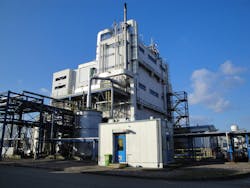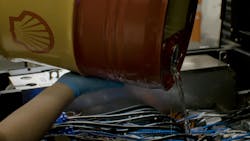Chemical Industry Capitalizes on Data Center Cooling Boom
What You’ll Learn
- Market Growth Drivers – How renewable energy, AI, and data center cooling are fueling demand for advanced heat transfer fluids.
- Innovations in Fluid Chemistry – New biodegradable, high-performance synthetic esters and immersion cooling solutions from industry leaders.
- Single- vs. Two-Phase Cooling – Key differences, advantages, and market trends shaping future thermal management strategies.
Heat transfer fluids always have been an essential part of reducing energy consumption and improving overall efficiency of thermal systems for chemical plant operations. As manufacturers of the fluids, the chemical industry has a vested interest in meeting demand in other markets, too.
Heat transfer fluid markets are experiencing significant growth, driven by renewable energy applications and evolving industrial needs. Market demand is projected to grow to $5.4 billion by 2029, fueled by sophisticated industrial processes in emerging economies across chemical, automotive, food, pharmaceutical and HVAC sectors, according to a Research and Markets report. A major catalyst is the explosive growth in data center cooling. Traditional air-cooling is being replaced by immersion cooling using specialized fluids, with this market expected to surge from $4.87 billion to $11.10 billion by 2030 — a 17.91% compound annual growth rate, according to Mordor Intelligence.
These trends are driving intensified research and development efforts, strategic partnerships with equipment manufacturers and a wave of new product launches across the industry.
Perstorp's High-Performance Synthetic Heat Fluids
Among companies capitalizing on these opportunities is Swedish specialty chemical manufacturer Perstorp. The company launched its portfolio of saturated synthetic polyol esters in June.
Perstorp developed its Synthetic-EF line to meet the lubricant industry’s evolving technical, environmental and performance demands. Synthetic-EF 5 is aimed at demanding, low-temperature applications; Synthetic-EF 15 is formulated for high performance and safety and Synthetic-EF 22 for applications with wide temperature ranges.
All three are registered with the European Union’s REACH regulation as biodegradable, while EF 15 is also registered for biodegradability according to Organization for Economic Co-operation and Development (OECD) standard 301. The other two are due to be tested for biodegradability to the OECD standard shortly (Figure 1).
“We have really focused on low- and very-low-viscosity products because they require much lower energy to pump while giving good cooling efficiency,” explained Valentina Serra-Holm, Perstorp’s head of engineered fluid solutions.
Overall, there's a trend toward environmentally friendly heat transfer fluids, including those that are biodegradable, she said. Esters are completely reusable because they can be broken down into their original components, providing opportunities for new end-of-life solutions. For instance, the company has been working closely with data centers interested in circular options for heat transfer fluids as they reach the end of their usable life, Serra-Holm said.
“The de-esterification reaction yields high-purity building blocks, suitable for reuse into new esters or other chemical products,” she added.
While synthetic esters have a long history of providing cooling, especially in electrical transformers, new applications are the driving force behind product developments by Perstorp and other vendors.
This includes the increasing use of energy-storage systems in chemical plants to provide supplementary or emergency energy.
“Similarly, chemical plants with mobile or containerized processing units may rely on independent heating, cooling and/or energy systems,” Serra-Holm said. “We also see that the chemical industry is shifting to electrical systems, and of course, in that context, immersion cooling of batteries can be used.”
Renewable energy systems also require heat fluids that operate efficiently at high temperatures while providing good thermal stability.
In addition, the ability to tailor the molecular structures of esters helps balance viscosities, thermal conductivities, oxidation resistance and other properties, enabling the development of fluid designed for specific applications, suggested Serra-Holm.
The rise of data centers has created significant market opportunities for heat-fluid manufacturers but with the challenge of navigating evolving regulatory standards.
In October 2024, Perstorp launched Synmerse DC, which the company describes as a high-performing, ester-based immersion cooling fluid. The company collaborated with processor manufacturers and original design manufacturers (ODMs) to develop the material and ensure its compatibility with next-generation computing technologies.
While tech companies like Intel are pioneering liquid cooling homologation, coordinated standards for emerging cooling applications remain absent.
In the meantime, Perstorp is working with OEMs and ODMs to ensure heat transfer fluid compatibility across hardware before approaching data centers.
“We start approaching actual data centers after securing that information because we can prove that our fluid is safe and compatible with their equipment,” Serra-Holm said. “This makes the process a bit lengthier, but also more reliable."
In terms of future developments, Serra-Holm believes chemistry is key, with the company keen to push the current limits in viscosity and expand its portfolio further.
“A priority is to develop a chemistry that allows us to tweak the fluid for a particular application and optimizing them for heat transfer and materials compatibility,” she noted. “This is where the partnership with component manufacturers is crucial.”
How Shell Keeps Data Centers Cool
Around the same time that Perstorp announced its Synthetic-EF line, Shell Lubricants launched its latest offering for direct liquid cooling (DLC).
A propylene glycol-based fluid, Shell designed DLC Fluid S3 for high-heat-load components in the densely packed server racks used by high-performance computing and AI operations.
By directly cooling high-performance components, such as central processing units and graphics processing units, DLC fluids can improve power use effectiveness by almost one-third when compared with air-cooling alternatives, the company said.
Shell quotes figures from the Mordor report and its own internal evaluations to suggest that such single-phase immersion cooling can help cut electricity demand in half, slash carbon dioxide emissions by up to one-third and nearly eliminate water consumption.
As with Perstorp, materials compatibility is a major consideration, and the company formulated DLC Fluid S3 to provide improved protection for aluminum and aluminum alloys. Being 2-ethylhexyl acrylate-, borate- and silicate-free, Shell said its formulation provides improved metal and rubber compatibilities over competitive formulations, too.
It also helps to protect the manufacturer’s warranty as there is no direct contact with the microprocessor, according to the company.
The new product launch came just a month after Shell claimed an industry first when its immersion cooling fluids were certified by Intel for use in data centers worldwide (Figure 2).
This followed a two-year collaboration between the two companies involving extensive testing and rigorous validation at Intel's Advanced Data Center Development Laboratory in Bangalore, India. Intel Xeon processors were found to remain as reliable with Shell’s immersion cooling fluids as with traditional air-cooled systems.
The certification, a Xeon processor single-phase immersion warranty rider, “affirms Intel’s confidence in the durability, efficiency and compatibility of immersion-cooled IT infrastructure with Shell immersion cooling fluids,” Intel stated in a news release.
Karin Eibschitz Segal, corporate vice president and interim general manager of the data center group at Intel, hailed the certification as a milestone that lays the foundation for future innovation and collaboration.
Another benefit of the certification includes the ability to skip the proof-of-concept phase and jump straight to pre-vetted solutions that deliver on industry needs with the backing from the industry first full certification and warranty options from Intel, said Selda Gunsel, chief technology officer and executive vice president of technology for Shell.
Shell’s single-phase immersion cooling fluids also are currently being used within two of its own data centers in Houston and Amsterdam.
The company would not comment on how these applications are performing, the nature of future collaborations with Intel or how its work to improve the biodegradability of its immersion fluids is progressing.
Chemours Targets Two-Phase Cooling Technology
Meanwhile, in May, Chemours announced a strategic agreement with digital infrastructure expert DataVolt from Saudi Arabia to develop advanced liquid cooling solutions for data centers.
This agreement includes the development of liquid cooling and other data center solutions using Chemours' portfolio of ultra-low global warming potential Opteon dielectric fluids designed to support AI and advanced digital infrastructure.
Unlike Shell’s direct liquid cooling approach, Chemours uses its Opteon fluids with a two-phase immersion cooling (2-PIC) technology.
Here, the dielectric liquid boils when in contact with hot server parts and turns into vapor. The vapor rises and condenses on a heat exchanger above the surface, returning to a liquid state in what the company describes as a perpetual and passive cycle. The liquid temperature remains constant.
Chemours points out that there is no need for pumps in the cooling process as there is with single-phase immersion cooling where the dielectric fluid is circulated to an external heat exchanger. A small auxiliary pump is used to circulate the fluid through a filter.
The company says that perfluorocarbons, hydrofluoroethers and fluoroketones have been safely and successfully used in 2-PIC systems, adding that it’s also evaluating a new family of fluids called hydrofluoroolefins.
The 2-PIC strategy provides nearly 90% cooling energy savings and up to a 40% reduction in total cost of ownership, according to the company. It also nearly eliminates water use and enables increased computing capacity and density per square foot without compromising performance, the company stated. Additionally, some of its liquid-cooling solutions support circularity, enabling heat and some fluids to be recovered and reused to drive further efficiency and sustainability benefits.
Also, in May the company announced an agreement with India-based specialty fluorochemicals manufacturer Navin Fluorine to manufacture Opteon. The move is part of Chemours’ expanding liquid-cooling venture and is considered an important step toward the 2026 commercialization of Opteon to support growing adoption of 2-PIC technology.
Chemours' timing aligns well with market dynamics: while single-phase designs hold 80% of the current market, two-phase systems are projected to grow over 20% annually, according to the Modor report. Two-phase technology offers superior heat removal through low-pressure boiling, enabling passive heat rejection without pumps or secondary loops, the report stated.
Even so, existing operators still favor single-phase systems for their maintenance simplicity and established supply chains, particularly mineral oil and synthetic hydrocarbon solutions that provide predictable viscosity and broad component compatibility. However, newer AI installations increasingly call for two-phase setups to eliminate pump failure risks and capture waste heat for district heating.
This creates a dual-track market in which single-phase will likely dominate legacy installations while two-phase captures new high-density builds. ⊕
About the Author
Seán Ottewell
Editor-at-Large
Seán Crevan Ottewell is Chemical Processing's Editor-at-Large. Seán earned his bachelor's of science degree in biochemistry at the University of Warwick and his master's in radiation biochemistry at the University of London. He served as Science Officer with the UK Department of Environment’s Chernobyl Monitoring Unit’s Food Science Radiation Unit, London. His editorial background includes assistant editor, news editor and then editor of The Chemical Engineer, the Institution of Chemical Engineers’ twice monthly technical journal. Prior to joining Chemical Processing in 2012 he was editor of European Chemical Engineer, European Process Engineer, International Power Engineer, and European Laboratory Scientist, with Setform Limited, London.
He is based in East Mayo, Republic of Ireland, where he and his wife Suzi (a maths, biology and chemistry teacher) host guests from all over the world at their holiday cottage in East Mayo.



